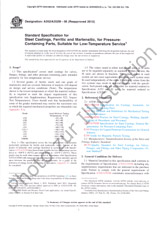Wir benötigen Ihre Einwilligung zur Verwendung der einzelnen Daten, damit Sie unter anderem Informationen zu Ihren Interessen einsehen können. Klicken Sie auf "OK", um Ihre Zustimmung zu erteilen.
ASTM D1990-19
Standard Practice for Establishing Allowable Properties for Visually-Graded Dimension Lumber from In-Grade Tests of Full-Size Specimens
Name übersetzen
NORM herausgegeben am 1.10.2019
Informationen über die Norm:
Bezeichnung normen: ASTM D1990-19
Anmerkung: UNGÜLTIG
Ausgabedatum normen: 1.10.2019
SKU: NS-975393
Zahl der Seiten: 33
Gewicht ca.: 99 g (0.22 Pfund)
Land: Amerikanische technische Norm
Kategorie: Technische Normen ASTM
Kategorie - ähnliche Normen:
Die Annotation des Normtextes ASTM D1990-19 :
Keywords:
ICS Number Code 79.040 (Wood, sawlogs and sawn timber)
Ergänzende Informationen
| Significance and Use | ||||||||||||||||||||||||
|
4.1 The procedures described in this practice are intended to be used to establish allowable stress and modulus of elasticity values for solid sawn, visually graded dimension lumber from In-Grade type test data. These procedures apply to the tested and untested sizes and grades when an adequate data matrix of sizes and grades exists. In addition, the methodology for establishing allowable stress and modulus of elasticity values for combinations of species and species groups is covered. Allowable stress and modulus of elasticity values may also be developed for a single size or a single grade of lumber from test data. 4.2 Methods for establishing allowable stress and modulus of elasticity values for a single size/grade test cell are covered in Practice D2915. The appropriateness of these methods to establish allowable stress and modulus of elasticity values is directly dependent upon the quality and representativeness of the input test data. 4.3 A monitoring program shall be established to periodically review the continued applicability of allowable properties derived by this practice. A monitoring program will establish data sets that are either the same as, above, or below the data that was used to develop the current allowable properties. Upon detection of a statistically significant downward shift, evaluation of the data and confirmation of remedial actions shall be undertaken. When evaluation is not undertaken or the results of the evaluation indicate an adjustment to allowable properties is appropriate, a reassessment shall be conducted to re-establish allowable properties. Note 5: It is recognized that over time there is the potential
for changes in the raw material or product mix. In response to this
a monitoring program must be conducted to ensure design values
derived by this practice are not invalidated by such changes. If
the data collected with a monitoring provides evidence of an
statistically significant downward shift in lumber properties an
evaluation program in accordance with the procedures of this
practice is needed to detect and confirm that responses to such
changes are appropriate. Evaluation, if undertaken, provides a
means for responding to the data and assessing if the actions taken
are sufficient. Following the confirmation of a statistically
significant downward shift, reassessment of values shall be
conducted if evaluation is either not undertaken or does not
adequately address the downward shift.
|
||||||||||||||||||||||||
| 1. Scope | ||||||||||||||||||||||||
|
1.1 This practice covers the principles and procedures for establishing allowable stress values for bending, tension parallel to grain, compression parallel to grain and modulus of elasticity values for structural design from “In-Grade” tests of full-size visually graded solid sawn dimension lumber. This practice also covers procedures for periodic monitoring, and additional procedures, if needed, for evaluation and possible reassessment of assigned design values. This practice is focused on, but is not limited to, grades which used the concepts incorporated in Practice D245 and were developed and interpreted under American Softwood Lumber PS 20. 1.2 A basic assumption of the procedures used in this practice is that the samples selected and tested are representative of the entire global population being evaluated. This approach is consistent with the historical clear wood methodology of assigning an allowable property to visually-graded lumber which was representative of the entire growth range of a species or species group. Every effort shall be made to ensure the test sample is representative of population by grade and size (see 7.1.1 and 7.1.2). 1.3 Due to the number of specimens involved and the number of mechanical properties to be evaluated, a methodology for evaluating the data and assigning allowable properties to both tested and untested grade/size cells is necessary. Sampling and analysis of tested cells are covered in Practice D2915. The mechanical test methods are covered in Test Methods D198 and D4761. This practice covers the necessary procedures for assigning allowable stress and modulus of elasticity values to dimension lumber from In-Grade tests. The practice includes methods to permit assignment of allowable stress and modulus of elasticity values to untested sizes and grades, as well as some untested properties. The practice includes procedures for periodic monitoring of the species or species group to quantify potential changes in the product and verification of the assigned design values through, evaluation, and reassessment. Note 1: In the implementation of the North American In-Grade
test program, allowable stress values for compression perpendicular
to grain and shear parallel to grain for structural design were
calculated using the procedures of Practice D245.
1.4 This practice only covers dimension lumber. 1.5 This standard does not purport to address all of the safety concerns, if any, associated with its use. It is the responsibility of the user of this standard to establish appropriate safety, health, and environmental practices and determine the applicability of regulatory limitations prior to use. 1.6 This international standard was developed in accordance with internationally recognized principles on standardization established in the Decision on Principles for the Development of International Standards, Guides and Recommendations issued by the World Trade Organization Technical Barriers to Trade (TBT) Committee. |
||||||||||||||||||||||||
| 2. Referenced Documents | ||||||||||||||||||||||||
|
Empfehlungen:
Aktualisierung der technischen Normen
Wollen Sie sich sicher sein, dass Sie nur die gültigen technischen Normen verwenden?
Wir bieten Ihnen eine Lösung, die Ihnen eine Monatsübersicht über die Aktualität der von Ihnen angewandten Normen sicher stellt.
Brauchen Sie mehr Informationen? Sehen Sie sich diese Seite an.




 Cookies
Cookies
